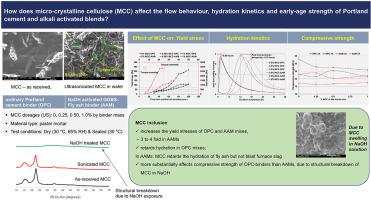Journal of Building Engineering ( IF 6.7 ) Pub Date : 2023-07-04 , DOI: 10.1016/j.jobe.2023.107218 R. Sri Bhanupratap Rathod , Pitabash Sahoo , Souradeep Gupta

|
该研究探讨了 MCC 对经过干燥和密封固化的 OPC 和 AAM 基质的流变行为、微观结构构建、水合动力学和早期强度(长达 7 天)的影响。流变测量表明,MCC 的添加提高了 OPC 基体的粘度恢复性和触变性。虽然 MCC-OPC 基质的粘度随着屈服应力变化相对较小而增加,但由于 MCC 含量从 0.25% 增加到 1%,MCC-AAM 的屈服应力急剧增加,在 15 分钟内高达 2.2 倍。这归因于 MCC 在 NaOH 中的凝胶化和溶胀。随着MCC剂量的增加,MCC-OPC在前24小时内的水化动力学严重延迟(1%MCC约5.3小时),而AAM的水化动力学对MCC剂量不太敏感,归因于接触 NaOH 后 MCC 中氢键的断裂。研究结果还表明,MCC 的添加减少了 AAM 水合 7 天后的放热,因为它对飞灰溶解有抑制作用。MCC-OPC 的早期抗压强度随着 MCC 含量的增加而持续降低,在 1% MCC 用量下最大降低 21%。与 OPC 基质相比,基于 MCC 的 AAM 的抗压强度对固化条件和 MCC 用量的敏感度较低。研究结果表明,MCC 可以成为一种强大的混合物,用于改变 OPC 和 AAM 基质的流变性和硬化,同时为纺织和生物质废物的升级回收提供途径。由于其对飞灰溶解的抑制作用。MCC-OPC 的早期抗压强度随着 MCC 含量的增加而持续降低,在 1% MCC 用量下最大降低 21%。与 OPC 基质相比,基于 MCC 的 AAM 的抗压强度对固化条件和 MCC 用量的敏感度较低。研究结果表明,MCC 可以成为一种强大的混合物,用于改变 OPC 和 AAM 基质的流变性和硬化,同时为纺织和生物质废物的升级回收提供途径。由于其对飞灰溶解的抑制作用。MCC-OPC 的早期抗压强度随着 MCC 含量的增加而持续降低,在 1% MCC 用量下最大降低 21%。与 OPC 基质相比,基于 MCC 的 AAM 的抗压强度对固化条件和 MCC 用量的敏感度较低。研究结果表明,MCC 可以成为一种强大的混合物,用于改变 OPC 和 AAM 基质的流变性和硬化,同时为纺织和生物质废物的升级回收提供途径。

"点击查看英文标题和摘要"




















































 京公网安备 11010802027423号
京公网安备 11010802027423号